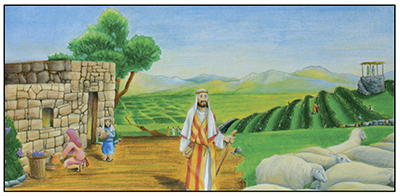The term used for “farmer” in the Bible is “husbandman.” A husbandman is a plowman, a man of the soil, a tiller of the ground.
In All the Trades and Occupations of the Bible, Herbert Lockyer writes that Jesus Christ’s frequent allusions to farmers, fields, and their products indicate how familiar he was with the agricultural pursuits of his time. Lockyer also notes that many farming methods then employed still prevail in the East, where change from antiquity is resisted.
In The Way It Was, Merrill T. Gilbertson explains why change comes slowly in the East:
…The climate, natural resources, and the culture were such that change was resisted even more than is normally true. Customs and manners were handed down from one generation to the next and were carefully guarded.
This article will look at some of the ancient customs involved in the farmer’s three main endeavors: growing grain, tending vineyards, and raising sheep. With an understanding of these customs, we can better comprehend the many scriptures that relate to agriculture in God’s Word.
The growing of grain involved plowing the ground to prepare for sowing the seed. Often the plowing and sowing were combined as one operation. The plow was made of two wooden beams, jointed T-fashion, and was usually pulled by two oxen. At times the plowing was done by village farmers as a team. Each farmer used his own equipment and oxen, and they plowed all the fields of the village.
Elisha was plowing with eleven other farmers and twenty-four oxen when the Prophet Elijah cast his mantle upon him, transferring his authority and power to Elisha.
I Kings 19:19:
So he departed thence, and found Elisha the son of Shaphat, who was plowing with twelve yoke of oxen before him, and he with the twelfth: and Elijah passed by him, and cast his mantle upon him.
Producing grain began in October or November, when the autumn rains had softened the soil. After planting the seed by scattering it by hand, the farmer went over the field again with his plow, or he dragged branches across it. This helped to bury the seed and protect it from birds or strong winds. The farmer hoed his fields from December until February to keep the weeds down.
In The New Manners and Customs of Bible Times, Ralph Gower relates that the main grain crops were wheat and barley, but some millet was also grown. Wheat grew in the Philistine plain, the Jordan Valley, and the valley of Jezreel. Barley could be grown just about anywhere and had a shorter growing season. Barley was not as valued as wheat.
When the grain was ready for harvest, or reaping, the workers would grab a handful of stalks and cut them with a sickle. The stalks were then tied in sheaves. This was done until the whole field was cut down. A lot of workers were needed to do this kind of work. The grain that was not tied in sheaves was left for the widows and poor people who came to glean behind the reapers as they worked.
In the Book of Ruth, we get a picture of the gleaners, one of whom was Ruth. She spoke to Boaz’s servant who was over the reapers.
Ruth 2:7 and 17:
And she said, I pray you, let me glean and gather after the reapers among the sheaves….
So she gleaned in the field until even, and beat out that she had gleaned….
Some fields were divided by paths, and people were permitted to pick by hand grain growing beside the paths (Deuteronomy 23:25). The twelve disciples who were with Jesus picked and ate the grain as they passed through a field one Sabbath day. The Pharisees thought they were breaking the law to do this on the Sabbath, but the truth was they only took the grain as allowed by the law.
Luke 6:1 [Lamsa translation]:
It came to pass on the sabbath, as Jesus walked through the wheat fields, his disciples plucked heads of wheat, and rubbed them in their hands and did eat.
After it was tied into sheaves, the grain was hauled to the threshing floor. Threshing separated the stems from the kernels of grain. The oldest method was to beat the stalks with a flail (a long, flexible stick). Another way to thresh was to use oxen pulling a wooden threshing sledge over the grain. The oxen’s hooves also helped separate the kernels of grain from the stalks.
After threshing, winnowing was done. Winnowing does a more precise job of separating the wheat from the chaff. The chaff is useless and would be burned. The farmer usually waited for a nice evening breeze, and the mixture of wheat and chaff was thrown into the wind on the threshing floor with a wooden fork and a spade, or winnowing shovel. The grain would fall to the ground, and the wind would carry the chaff away.
Psalm 1 contains a figure of speech comparing the ungodly to chaff and also a literal truth about the farmer’s winnowing:
Psalms 1:4:
The ungodly are not so: but are like the chaff which the wind driveth away.
Some farmers went even further and used a sieve to filter the grain to be sure it was pure. This was a final step in processing the grain. The farmer then stored most of his grain. Some grain was kept for his family’s use; some was sold right away; and some was stored and sold at a later time….
This is an excerpt from the March/April 2005 issue of The Way Magazine.
Copyright© 2005 by The Way International. All rights reserved.
For more information on subscribing to The Way Magazine, Click Here

